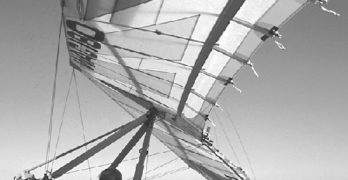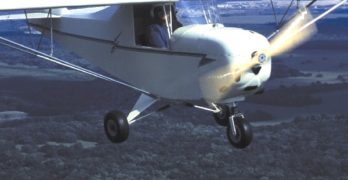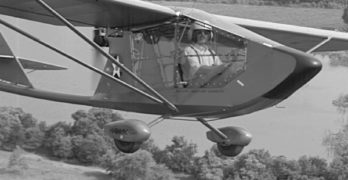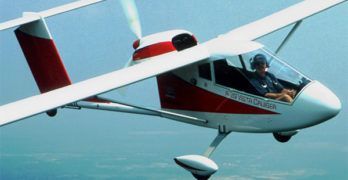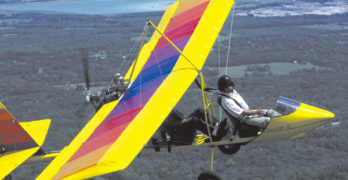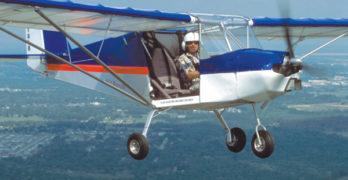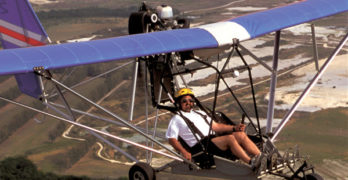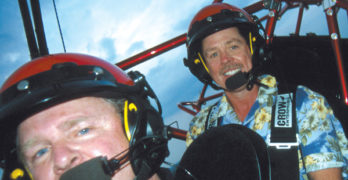More than one European writer has called the single-seat Air Création Racer “the best ultralight in the world.” That’s a pretty big statement in a world full of wonderful recreational aircraft. Can it measure up? The short answer is, “Yes, very possibly it can!”
The best ultralight in the world? Really? Well, this is too sweeping a statement. No one knows which ultralight is truly the best because best is different for every person. What is best for you may not be best for me.
This very point has crystallized my response to many pilots who ask me at airshows, “You’ve flown everything. What should I buy?” I can’t answer the question because I don’t know what you want. Only after a lengthy conversation and watching you fly could I even hazard a guess about the best ultralight for you. Even then, it’s too likely I’d be wrong.
Nonetheless, some aircraft are clear winners and others aren’t so strong.
Search Results for : Flight Design
Not finding exactly what you expected? Try our advanced search option.
Select a manufacturer to go straight to all our content about that manufacturer.
Select an aircraft model to go straight to all our content about that model.
Carlson Sparrow Single-Place Ultralight Aircraft
Carlson’s White-Throated Sparrow 503
General aviation pilots who visit the ultralight area at an air show often regard some aircraft with apprehension, wondering if these different-looking machines are indeed actually airworthy.
In the early days of ultralight aircraft, many designs were in fact of questionable quality. These days, however, the aircraft you see on display generally are solid machines with admirable safety records.
It’s a little confusing at first, but not all ultralights are officially Ultralights. Some weigh just a little too much — a product of trying to satisfy customers by adding larger engines and other features. Some fly a little too fast or carry a little too much fuel. It doesn’t take much to barely miss the tight FAR Part 103 regs.
Fortunately that doesn’t matter much to Flyer readers, as the majority of us have private pilot certificates and our medicals are current. We can simply put an N-number on our ultralight-like aircraft and fly it as we would any certified airplane.
Hawk Plus
CGS’ new Hawk Plus
As the year 2000 approaches, computer programmers may be sweating that Y2K bug we’ve all heard way too much about. Ultralight enthusiasts, on the other hand, will be celebrating the completion of two full decades as a member of the aviation community. Throughout the 1980s and 1990s, a lot has happened.
This newest community of pilots and designers learned a great deal. Accidents are far lower than in the “old” days, and equipment is far better. Specifically, ultralight aircraft designs are the best we’ve seen, with many reliable brands offering airworthy sport-flying machines.
Buyers of ultralights include those lightweight enthusiasts who enjoy Part 103’s freedom from FAA licenses, registration or certification. That’s why ultralights can be bought for $10,000 to $15,000, and you don’t need an FAA ticket to fly one legally. That fact practically assures that ultralights will stay on the radar of many aging baby-boomer pilots.
Product Lines from June 2002
ST. PAUL, MINN. — The Wallaby Open started the season with a bang. While wet spring weather brought challenges, four valid rounds left Ukrainian Oleg Bondarchuk as the winner of the flex-wing class, beating Italian Manfred Ruhmer and Yankee Paris Williams in a field of 72 pilots. Mike Barber (6th), Chris Arai (10th), Jim Lee (17th), and Curt Warren (18th) were among Americans in the top 20 finishers.
For rigid wings now grouped in Class 5, Alex Ploner held his title taking first over fellow Italian Christian Ciech. Top Yankees were Bruce Barmakian, Davis Straub, Campbell Bowen, and Heiner Biesel in 4th through 7th respectively. This class saw ATOS dominating with 63% of the field, Ghostbusters at 13% and five other models in the field of 24 Class 5 rigids.
Brian Porter again won in Class 2 rigid wings flying his Swift, though he competed only against Brit’ Robin Hamilton in another Swift.
Product Lines from May 2002
ST. PAUL, MINN. — My opening segment should start, “Once upon a time, there was Escape Pod, Pod Racer, and Porky Pod…” You’d probably be baffled (though perhaps intrigued). I’m referring to the Pod series from former Seagull hang glider boss, Mike Riggs. I’ve unabashedly promoted this project since it came from my challenge for a true “soaring trike.”
Pods are sleek fuselages to house pilots attached to hang glider wings. Their goal is to offer more comfort, low drag and light weight, and a rigid attachment to the glider. You fly seated/supine — and have a full enclosure. Think of a powered ultralight trike except one with all the draggy bits pulled inside. Escape Pod and Pod Racer (and surely Porky Pod, too, when it’s ready) will feature fully retractable tri-gear, in-flight C/G adjustment, and a molded clear plastic canopy that fits smoothly to a composite body. A positive aspect is the rigid connection to glider, such that you can never fall into the wing, possibly preventing broken gliders after a tumble or tuck.
Aeroprakt’s A-20 Vista Cruiser
UPDATE–November 2008: According to FPNA, an American company with a business relationship to A-20 producer Aeroprakt, the A-20 has been discontinued. Please contact FPNA for more information (contact info at end of article).
Two summers ago Americans saw a new aircraft from a Ukrainian company called Aeroprakt as U.S. importer Spectrum Aircraft brought in the A-22 Valor. It would be only the first in a fleet of new microlights.
Later another model from Aeroprakt appeared. In fact, the Vista series comprises 5 models, all variations on a basic theme that is nothing like the Valor. At present, the Ukraine enterprise has no less than nine models including the Valor, Vista, Cruiser, V-STOL, V-SS, Vulcan, Vulcan-SS, Victor single engine, Victor twin, and Viking. Four of this series are twin-engine aircraft, none are alike, and one is a 4-seater. By any measurement, this is quite an accomplishment from a company less than 10 years old and rising from the ashes of the failed Communist empire.
Super Drifter XL with Rotax 912
Considered by many to be a workhorse, the Super Drifter XL shows refinement and features that make it seem like a “luxury ultralight.” Leza AirCam, the newly renamed producer of this venerable ultralight, has equipped the top-of-the-line model with nearly every option in their price list. Conclusion: While it will cost you a bundle, you should be satisfied with this ultralight for many years.
How is this Super Drifter XL different from the Super Drifter that I evaluated almost 3 years ago? According to Denny Franklin – yes, that same icon of the Maxair days when the Drifter was a youngster – the XL is a significant redesign of the original Super Drifter 912 flown in 1998.1 It has seen numerous changes to make the veteran design work better with the big 80-hp Rotax 912 situated at the rear of the wing.
What’s New With the Super Drifter XL?
The Super Drifter XL has an extended fuselage – meaning the boom tube and its fuselage “pan” – to position the front seat 5 inches further forward.
French Quick-Build 2 Seater
One of the most popular club planes in France is widely used by instructors in that country. Now we welcome the Sky Ranger to North American skies.
In France, as with much of Europe, many ultralights are owned by aero clubs which frequently manage recreational airfields throughout the continent. Run a little differently in each location, they provide common ways for average pilots to fly and for newcomers to be introduced to flight. Virtually all aero clubs provide instruction, often through associated flight schools. Clubs also own and maintain aircraft – lots of them. This has worked especially well with sailplanes; Europe has more than twice as many sailplanes as the United States and several times the pilot population. Ultralight enthusiasts have followed this example.
The Sky Ranger arrived in the mid-1990s at French ultralight aero clubs that dot the landscape, and has done very well. U.S. importer Sabre Aircraft says, “It’s the most popular ultralight in France, especially with the flight schools.” In more than just 6 years, the company claims deliveries of about 500 aircraft.
M Squared’s Breese 2
Customers spoke and M-Squared acted. This proves the marketplace works, where customers “vote” with every dollar spent to acquire certain products. More importantly to pilots, this fact explains why a review of M-Squared’s new 2-seater – the Breese 2 – is good for customers.
Customers liked what M-Squared was doing. The 1996 company startup took a popular Quicksilver airframe design, added struts and beefed up the airframe to accept engines as large as the 100-hp Rotax 912S. But pilots also liked the way the original Quicksilvers (which are lighter) flew and handled. Being in business to serve customers, M-Squared acted appropriately.
Paul Mather and M-Squared responded to requests for a lighter version of their 2-seat Sport 1000 in a series of steps. First came the single-surface wing Sprint 1000, which dropped a few pounds by not using the big pod of the first Sport 1000. Then came the Breese SS (single-surface) and Breese DS (double-surface) single-seaters, which were obviously lighter and more agile.
Destiny Powered Parachutes
In recent months, several industry observers have noted that powered parachutes’ sales appear to be stronger than fixed-wing sales. Many visitors count a large number of powered parachute manufacturers at airshows. Insiders hear rumors about the large volume of engines these companies are buying. Perhaps you’ve even said, “There’s one flying at my home field now.”
Much like trikes before them, the sales of powered parachutes (and powered paragliders) seem to be increasing. Most new flying machine types have their day, and currently powered parachutes appear to be enjoying a great run.
Growing Segment
Despite the fact that the planet supports only a couple million pilots, aviation is highly segmented. Flyers in America enjoy the broadest choices imaginable with aircraft of every description. This incredible diversity is vast enough that we tend to focus only on the types of flying machines that interest us (or that we can afford).
The concept of a parachute (canopy) acting as your wing isn’t particularly new.


